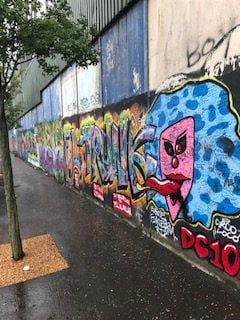
This morning, our group of scholars visited the Peace Wall in Belfast. Personally, I had a vague understanding of the divide that exists between Catholics and Protestants in Ireland, but I had yet to experience this separation up close. As we approached the wall, SCL staff began to explain the significance behind the wall, and why it is such an iconic place in Belfast. Stepping off the bus and approaching the wall was nothing short of eye-opening. Thousands of messages scribbled in black ink and graffiti were scattered as far as the wall runs. Many of the messages promoted peace between the two sides. Immediately, the Peace Wall provided us with a physical representation of controversy, hatred, and violence that’s existed on the streets of Belfast for decades. As I looked up the wall, a chain fence was planted on top of the original foundation, adding at least 20 feet to the height of the barrier. When I asked a staff member why the fence was needed, he answered that the original foundation “was not tall enough” to keep Catholics and Protestants from throwing objects over the wall to try to harm the other side.
Of the thousands of messages written on the structure, one of the most compelling notes was the following: “There must be no wall if we seek to be a unified people.” Interestingly enough, this drew a strong connection to a major point of controversy that I can relate to, especially as the United States’ government seeks to harden the border between my country and Mexico. The implications of this type of divide have a substantial impact on togetherness and unity. It is amazing that in a small country like Ireland, such great divide exists, especially between two groups that share the same skin color.